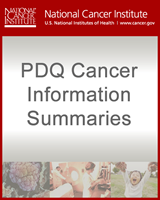From: Genetics of Skin Cancer (PDQ®)

PDQ Cancer Information Summaries [Internet].
Bethesda (MD): National Cancer Institute (US); 2002-.
NCBI Bookshelf. A service of the National Library of Medicine, National Institutes of Health.
| Syndrome | Inheritance | Gene or Chromosomal Loci | Clinical Findings |
|---|---|---|---|
| Basal cell nevus syndrome, Gorlin syndrome | AD | PTCH1,[130,131] PTCH2,[44] SUFU [68] | BCC (before age 20 y) |
| Rombo syndrome | AD | Unknown | Milia, atrophoderma vermiculatum, acrocyanosis, trichoepitheliomas, and BCC (age 30–40 y) |
| Bazex-Dupré-Christol syndrome | XD > AD | Xq24-27 [117] | Hypotrichosis (variable),[114] hypohidrosis, milia, follicular atrophoderma (dorsal hands), and multiple BCCs (aged teens to early 20s) [114] |
| Brooke-Spiegler syndrome | AD | CYLD [132,133] | Cylindroma (forehead, scalp, trunk, and pubic area),[134,135] trichoepithelioma (around nose), spiradenoma, and BCC |
| Multiple hereditary infundibulocystic BCC | AD [136] | Unknown | Multiple BCC (infundibulocystic type) |
| Schopf-Schultz-Passarge syndrome | AR > AD | Unknown | Ectodermal dysplasia (hypotrichosis, hypodontia, and nail dystrophy [anonychia and trachyonychia]), hidrocystomas of eyelids, palmoplantar keratosis and hyperhidrosis, and BCC [137] |
| Xeroderma pigmentosum | AR | XPA, XPB/ERCC3, XPC, XPD/ERCC2, XPE/DDB2, XPF/ERCC4, XPG/ERCC5 | SCC, BCC, melanoma, severe sun sensitivity, ophthalmologic and neurologic abnormalities |
| Xeroderma pigmentosum variant | AR | POLH | SCC, BCC, melanoma, severe sun sensitivity, ophthalmologic abnormalities |
AD = autosomal dominant; AR = autosomal recessive; SCC = squamous cell carcinoma; XD = X-linked dominant.
From: Genetics of Skin Cancer (PDQ®)

NCBI Bookshelf. A service of the National Library of Medicine, National Institutes of Health.